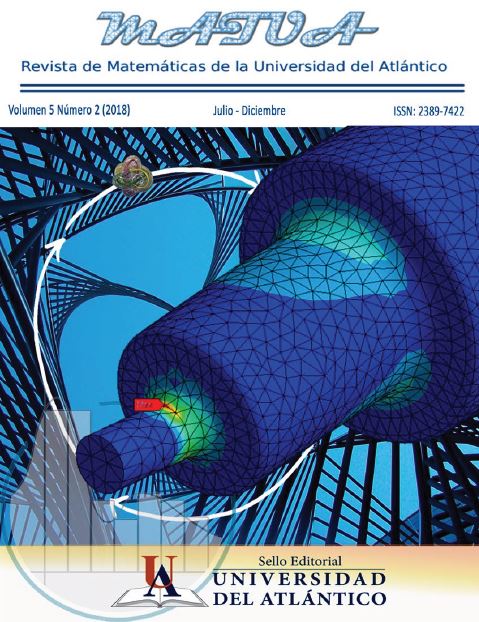USE OF INFORMATION AND COMMUNICATION TECHNOLOGIES BASED ON TEACHING AND LEARNING STRATEGIES FOR THE DEVELOPMENT OF MATHEMATICAL COMPETENCES.
Abstract
The objective of this research is to determine the use of information and communication technologies based on teaching and learning strategies for the development of mathematical competencies in eleventh grade students of the Barranquilla district, department of Atlántico - Colombia. It was based on the theories of: Batanero (2014), Romero and Araujo (2014), UNESCO (2007), Salinas (2004) and Gómez (2014). The research was descriptive, with a non-experimental, transectional, field design. The population consisted of 154 students of the eleventh grade and 86 teachers. The reliability of the instrument yielded a coefficient of 0.90 defined as a very high reliability. The statistical techniques used for the analysis of the data were descriptive and inferential: one-way ANOVA and student's t. It is concluded that the students of the eleventh grade stood out in the lower category, when it comes to using technological tools in solving mathematical problems through the tutorial, simulators and programmed instruction. In the same way, they present difficulties for solving problems by applying elementary operations through teaching and learning strategies. Other findings indicate that teachers have low skills in the use of ICT, so their work is weak in the context of secondary education. There is a low correspondence between the traditional class taught by the teacher and the use of technologies for the development of mathematical competence. It is recommended to establish a curriculum and content in the area of mathematics adjusted to teaching and learning strategies that involve the use of ICT for the development of mathematical skills.Visitas al artículo
Downloads
References
Arias , F. (2012). El proyecto de investigación. 6° edición.Caracas : Editorial Episteme.
Batanero, C. (31 de julio de 2014). Probability teaching and learning En S. Lerman (Ed.).Encyclopedia of Mathematics Education. Springer. Disponible en: . Recuperado el 5 de julio de 2016.
Cabero, J. (2007). Nuevas tecnologías aplicadas a la educación. España: Mc Graw Hill.
Colorado, B., y Edel, R. (2011). La usabilidad de TIC en la práctica educativa. Recuperado el 19 de enero de 2016, de http://www.um.es/ead/red/30/edel.pdf
Chávez, N. (2007). Introducción a la investigación educativa. Caracas : Gráfica González .
Del Valle , L. (2011). Detección de Alumnos Talentosos en un Área de la tecnología. Recuperado el Junio de 2016, de http://eprints.ucm.es/12414/1/T32499.pdf
Dorrego, M. (2011). Caracteríticas de la instrucción programada como técnica de enseñanza. Revista de pedagogíadr2s , 24.
Finol, M. y Camacho, H. (2009). El proceso de investigación científica. 2da. Edición. Maracaibo – Venezuela: Ediluz.
Gomez , E. (2014). Evaluacion y desarrollo del Conocimietno Matematico para la Enseñanza de la Probabilidad . Recuperado el 21 de Agosto de 2016.
Hernández, R., Fernández, C, y Baptista, P. (2014). Metodología de la Investigación. 6ta. Edición. México: McGraw Hill.
Hurtado, J. (2010). Metodología de la Investigación. Guía para la comprensión holística de la ciencia. Cuarta edición. Bogotá – Caracas: Ediciones Quirón.
Laborí , B., Echeverría , J., y Oleagordia, I. (2011). Estrategia Educativa para el uso de las nuevas Tecnologías de la información y comunicación. Recuperado el 19 de enero de 2016, de http://www.rieoei.org/deloslectores/Labori.PDF
Méndez , A. (octubre de 2015). Recuperado el diciembre de 2016, de http://publicaciones.urbe.edu/index.php/revecitec/article/viewArticle/3792/5089
Ramos , A., y Begoña , V. (enero de 2016). Comillas . Recuperado el 6 de junio de 2016, de http://www.iit.comillas.edu/aramos/presentaciones/t_mms_M.pdf
Romero, S., y Araujo, D. (2014). Factores Claves Presentes en el uso de las TIC. Congreso Internacional URBE, 517 - 531.
Salinas , J. (octubre de 2004). Cambios metológicos con las TIC. Recuperado el diciembre de 2016.
Santos, J. (2004). La Resolución de Problemas Matemáticos: Avances y Perspectivas en la Construcción de una Agenda de Investigación y Práctica. Recuperado el diciembre de 2016, de http://www.uv.es/puigl/MSantosTSEIEM08.pdf
Santos, M. (octubre de 2007). La Resolución de Problemas Matemáticos: Avances y Perspectivas en laConstrucción de una Agenda de Investigación y Práctica. Recuperado el 8 de junio de 2016, de http://www.uv.es/puigl/MSantos TSEIEM08.pdf
Ulam , S., y Von, J. (1975). Simulación Monte Carlo. Recuperado el 06 de junio de 2016, de http://www.uoc.edu/in3/emath/docs/Simulacion_MC.pdf
UNESCO. (1994). Obtenido de http://unesdoc.unesco.org/images/0011/001107/110753so.pdf


